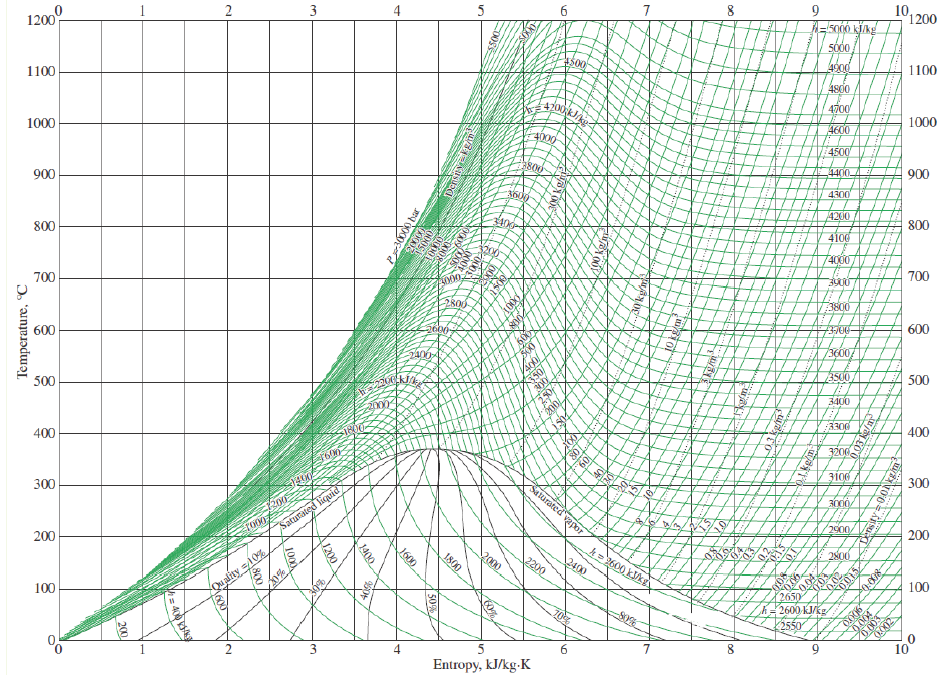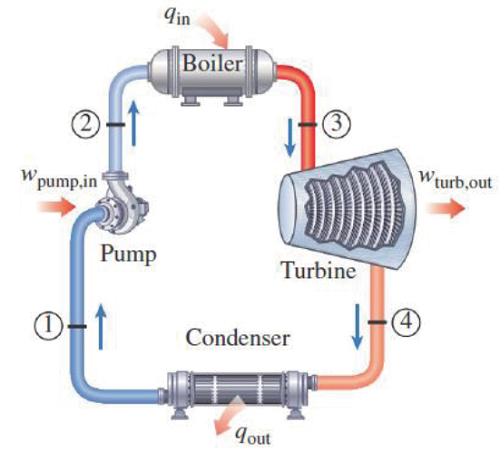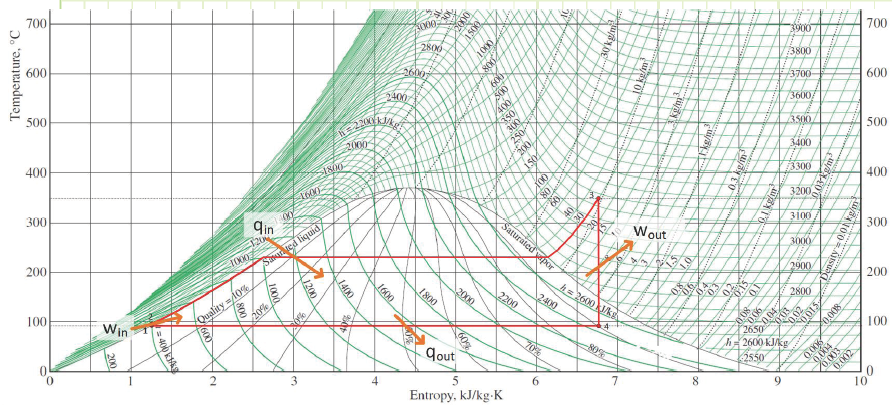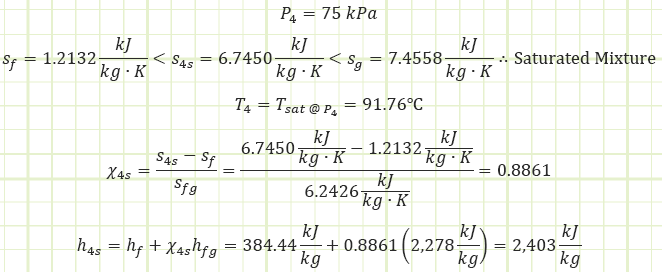Related Resources: thermodynamics
Steady Flow Vapor Power Cycles Thermodynamics – Rankine Cycle - Class 12
Thermodynamics Data, Equations, Charts, Equations and Calculators
Steady Flow Vapor Power Cycles – Rankine Cycle - Class 12
Objective(s):
At the completion of the lecture, students should:
1) Understand how P-v and T-s diagrams depict properties of multiphase systems.
2) Understand and apply the property of Quality with regard to saturated liquid-vapor mixtures.
3) Identify the reference states, processes, and associated energy interactions of the Rankine cycle.
4) Analyze a multiphase steady flow system using the Rankine Cycle with non-unity isentropic efficiencies.
Methodology:
Lecture with animations and video (Steam Power 1 , Steam Power 2 , Steam Turbines , steam turbines 2 , steam turbines 3 ) shown via projector.
Terminology:
Latent Heat: The amount of thermal energy required to cause a change in phase of a substance. Latent Heat of
Fusion is the energy required to cause melting (when heat is added) or freezing (when heat is extracted). Latent Heat of Vaporization is the energy required to cause vaporization (when heat is added) or condensation (when heat is extracted). Temperature does not change during a constant pressure latent heating process.
Sensible Heat: The thermal energy associated with a change in temperature of a substance.
Saturation: When a substance is either about to undergo or is currently undergoing a phase change. At saturation, temperature and pressure are fixed and no longer independent from each other. Any addition of heat will cause further phase change and no change in temperature when pressure is constant as long as the two different phases continue to coexist.
Vapor pressure: The pressure required to keep a substance being held at a certain temperature as a liquid. A decrease in pressure below the vapor pressure will allow vaporization to occur.
Compressed liquid: Also called “subcooled liquid,” is a liquid that is not about to vaporize; either its pressure must decrease or temperature must increase (or a combination of the two) in order to cause vaporization. Specific internal energy, specific enthalpy, specific entropy, and specific volume are not strong functions of pressure for a compressed liquid, and for moderately small pressures, they can be approximated as being equal
to that of a saturated liquid having the same temperature, (i.e. hour liquid = hf of saturated liquid @ our liquid’s T).
Saturated liquid: A liquid that is about to vaporize if any heat is added, otherwise it will become a compressed liquid.
Saturated mixture: When a saturated liquid and saturated vapor coexist heat addition causes more vaporization. Heat removal causes more condensation.
Saturated vapor: When a vapor is about to condense if any heat is removed, otherwise it will become superheated.
Superheated vapor: A vapor that is not about to condense. Adding heat raises it temperature, removing heat lowers its temperature.
Critical point: The temperature and pressure at which a liquid becomes indistinguishable from a vapor. Above the critical temperature, no amount of pressure will force condensation to occur.
Landmark Properties:
vf: Specific volume of a saturated liquid. vg: Specific volume of a saturated vapor. vfg: vg - vf: The space between the saturated vapor and saturated liquid lines representing the net change in specific volume of a substance as it completely vaporizes from a saturated liquid state to a saturated vapor state. The foregoing also applies for u, h, and s.
χ: Quality. The ratio of saturated vapor mass against total mass of a substance in a system. Only a relevant property for a substance inside the vapor dome (a saturated mixture). Ranges between 0 (saturated liquid) and 1 (saturated vapor).

How do we use this information?
Appendices A-4 & A-5 display saturated mixture data for water. Appendix A-6 shows superheated steam. Appendix A-7 shows compressed liquid water. Similar appendices exist for R-134a or you can go to the NIST Chemistry WebBook to generate information tables for just about any common substance.
Sometimes, especially in the superheated vapor region, you’ll need to linearly interpolate between values.
Rankine Cycle:
The vapor power cycle associated with the majority of power generation on Earth today (just add water..and heat).
Usually uses water (and steam) as the working fluid (but doesn’t have to! Some were built to use Mercury…). Cycle consists of four processes:
1) Isentropic pressurization in a pump (State 1 to State 2). The substance is taken in as a saturated liquid at a lower pressure and pressurized isentropically in a pump to a higher pressure. The work input is:
2) Isobaric heating in a boiler (State 2 to State 3). Heat is added, the substance completely vaporizes and becomes superheated until the turbine inlet temperature is achieved. The heat input is:
![]()
3) Isentropic expansion in a turbine (State 3 to State 4). The substance expands to a lower pressure in a turbine, producing work.

4) Isobaric cooling in a condenser (State 4 to State 1). The substance at lower pressure rejects heat to a temperature sink until it once again becomes a saturated liquid.
![]()
Overall cycle performance:
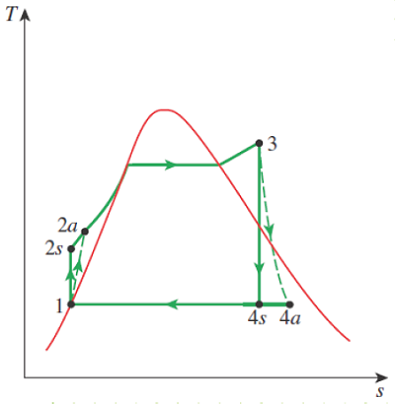
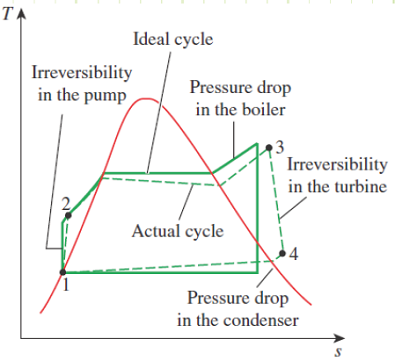
EXAMPLE 1 – SIMPLE RANKINE CYCLE.
Problem statement:
Power plant operating on simple Rankine Cycle with given properties.
Given:
Properties at State (3):
T3 = 350°C ; P3 = 3 MPa
Property at State (4):
P4 = 75 kPa
Find: a) Cycle thermal efficiency.
Assumptions:
1) Saturated liquid at pump inlet.
2) Ideal Rankine Cycle (no irreversibilites nor pressure losses; only evaluate “s” subscripts for states 2 & 4).
Solution:
Determine properties at important stages in the cycle:
Properties at State 1 (Saturated Liquid):
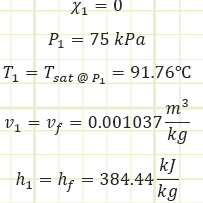
Process 1 → 2 (Isentropic compression in a pump):
Properties at State 2 (Compressed Liquid):
Properties at State 3 (Superheated Vapor):
Process 2 → 3 (Isobaric heating in a boiler):
Properties at State 4 (Saturated Mixture):
Process 3 → 4 (Isentropic expansion in a turbine):
Process 4 → 1 (Isobaric cooling in a condenser):
Cycle Performance Metrics:
Source
Unknown Contributor - Reddit
Related:
- Introduction to Thermodynamics, Class 1
- Ideal Gas Assumptions, Properties of Pure Substances, Property Tables, Class 2
- Control Volume Analysis, Reynolds Transport Theorem, Conservation of Mass, and the First, Class 3
- Mechanical Work for Closed Systems Class 4
- Properties of Pure Substances , Phase Changes Class 5
- Thermodynamics of Multiphase Closed Systems Class 6
- Analysis of Open Systems Thermodynamics Class 7
- Introduction to Otto Cycle, Cycle Thermal Efficiency, Spark-Ignition Engine Architecture, and Combustion Cycle Class 8
- Closed System Cycles Ideal & Real Diesel Cycle Class 9
- Closed System Cycles Thermodynamics – Carnot Cycle & Entropy Class 10
- Steady Flow Gas Power Cycles – Brayton Cycle Class 11
- FIRST LAW OF THERMODYNAMICS
- SECOND LAW OF THERMODYNAMICS
- Thermodynamic Systems and Surroundings
- Types of Thermodynamic Systems
- Thermodynamic Equilibrium
- Control Volume
- Steady State
- Thermodynamic Process
- Cyclic Process
- Reversible Process
- Irreversible Process
- Adiabatic Process
- Isentropic Process
- Polytropic Process
- Throttling Process
